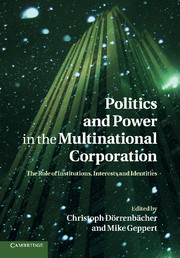 Politics and Power in the Multinational Corporation
Politics and Power in the Multinational Corporation Published online by Cambridge University Press: 26 April 2011
Introduction
Scholars have recently pointed out that intra-organizational conflict in multinational corporations (MNCs) between headquarters (HQ) and their foreign subsidiaries is not necessarily dysfunctional (Dörrenbächer and Geppert 2006; see also chapter by Blazejewski and Becker-Ritterspach in this volume) or a sign of unsuccessful global integration (Bouquet and Birkinshaw 2008; Tasoluk et al. 2006), as often stressed in previous management research. Instead, the growing importance of foreign subsidiaries, especially from large emerging markets, requires a different approach when managing headquarters–subsidiary relationships. This includes a departure from the traditional antagonistic view of the global integration versus local responsiveness quandary. This chapter aims to advance the literature on MNC headquarters–subsidiary relationships by adding new insights to the global versus local discussion (Bartlett 1986; Bartlett and Ghoshal 1989; Ghemawat 2007; Prahalad and Doz 1987; Roth and Morrison 1990).
Global integration refers to strategic and organizational activities that seek to reduce organizational and operational dissimilarities between different MNC subunits (Prahalad and Doz 1987). The objectives of global integration include efficiency improvements through aggregation, the exploitation of scope and scale economies, and the transfer of knowledge and practices across the MNC network. Local responsiveness refers to subsidiary decision-making autonomy while responding to local customer needs and specific host market competitive demands (Bartlett 1986; Doz and Prahalad 1991). Local responsiveness activities usually increase intra-organizational heterogeneity in MNCs.
To save this book to your Kindle, first ensure [email protected] is added to your Approved Personal Document E-mail List under your Personal Document Settings on the Manage Your Content and Devices page of your Amazon account. Then enter the ‘name’ part of your Kindle email address below. Find out more about saving to your Kindle.
Note you can select to save to either the @free.kindle.com or @kindle.com variations. ‘@free.kindle.com’ emails are free but can only be saved to your device when it is connected to wi-fi. ‘@kindle.com’ emails can be delivered even when you are not connected to wi-fi, but note that service fees apply.
Find out more about the Kindle Personal Document Service.
To save content items to your account, please confirm that you agree to abide by our usage policies. If this is the first time you use this feature, you will be asked to authorise Cambridge Core to connect with your account. Find out more about saving content to Dropbox.
To save content items to your account, please confirm that you agree to abide by our usage policies. If this is the first time you use this feature, you will be asked to authorise Cambridge Core to connect with your account. Find out more about saving content to Google Drive.